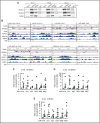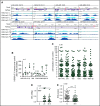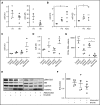Targeting BTK through microRNA in chronic lymphocytic leukemia
- PMID: 27756747
- PMCID: PMC5201097
- DOI: 10.1182/blood-2016-07-727750
Targeting BTK through microRNA in chronic lymphocytic leukemia
Abstract
Bruton's tyrosine kinase (BTK) is a critical mediator of survival in B-cell neoplasms. Although BTK inhibitors have transformed therapy in chronic lymphocytic leukemia (CLL), patients with high-risk genetics are at risk for relapse and have a poor prognosis. Identification of novel therapeutic strategies for this group of patients is an urgent unmet clinical need, and therapies that target BTK via alternative mechanisms may fill this niche. Herein, we identify a set of microRNAs (miRs) that target BTK in primary CLL cells and show that the histone deacetylase (HDAC) repressor complex is recruited to these miR promoters to silence their expression. Targeting the HDACs by using either RNA interference against HDAC1 in CLL or a small molecule inhibitor (HDACi) in CLL and mantle cell lymphoma restored the expression of the BTK-targeting miRs with loss of BTK protein and downstream signaling and consequent cell death. We have also made the novel and clinically relevant discovery that inhibition of HDAC induces the BTK-targeting miRs in ibrutinib-sensitive and resistant CLL to effectively reduce both wild-type and C481S-mutant BTK. This finding identifies a novel strategy that may be promising as a therapeutic modality to eliminate the C481S-mutant BTK clone that drives resistance to ibrutinib and provides the rationale for a combination strategy that includes ibrutinib to dually target BTK to suppress its prosurvival signaling.
© 2016 by The American Society of Hematology.
Figures







Comment in
-
Releasing the brakes on BTK-targeting miRNA.Blood. 2016 Dec 29;128(26):3023-3024. doi: 10.1182/blood-2016-11-748145. Blood. 2016. PMID: 28034867 No abstract available.
References
-
- Hallek M, Cheson BD, Catovsky D, et al. ; International Workshop on Chronic Lymphocytic Leukemia. Guidelines for the diagnosis and treatment of chronic lymphocytic leukemia: a report from the International Workshop on Chronic Lymphocytic Leukemia updating the National Cancer Institute-Working Group 1996 guidelines. Blood. 2008;111(12):5446-5456. - PMC - PubMed
-
- Wiestner A. Targeting B-Cell receptor signaling for anticancer therapy: the Bruton’s tyrosine kinase inhibitor ibrutinib induces impressive responses in B-cell malignancies. J Clin Oncol. 2013;31(1):128-130. - PubMed
MeSH terms
Substances
Grants and funding
LinkOut - more resources
Full Text Sources
Other Literature Sources
Molecular Biology Databases
Miscellaneous

